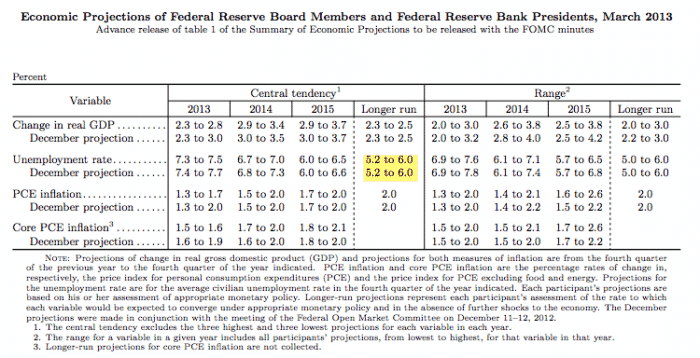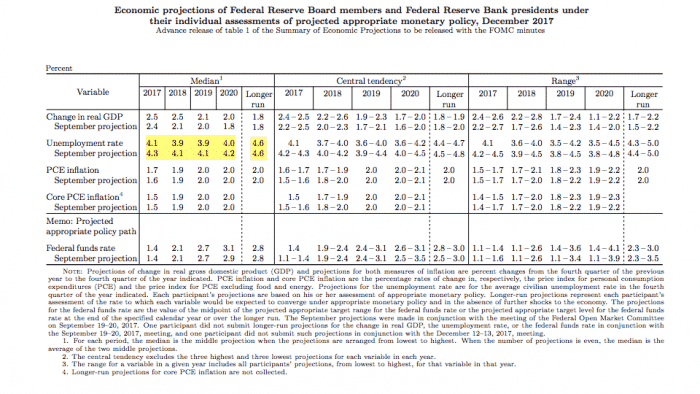The three things to look for in these Fed projections
The Federal Open Market Committee of the Federal Reserve meets today and tomorrow. It has scheduled a policy statement release for tomorrow, with a press conference by Chairman Jerome Powell to follow. Market participants are nearly unanimous in expecting the Fed to announce a quarter percent increase in the federal funds target. But there a few other things to look for regarding clues to future Fed policy. They are the dot plot, long-run unemployment, and 2018 growth projections.
Look to the dot plot
The Fed takes ‘forward guidance’ seriously as a primary conduit through which monetary policy impacts the economy. Fed officials always say that interest rate policy is the Fed’s primary weapon for conducting monetary policy. And that has a huge impact on short-term interest rates. In fact, because the Fed’s credibility as monopoly supplier of reserves for US dollars is so good, it simply has to announce a target rate and the market will move to that rate without the Fed intervening in any way.
But it is the messaging around future policy – forward guidance – that transmits Fed power over the market regarding longer-term interest rates. And the Fed has become increasingly transparent about providing guidance here. Since January 2012, the Fed has even provided forecasts for economic growth, unemployment, and inflation for the coming few years. And these projections are accompanied by a dot plot — a chart showing the federal funds rates that Fed officials believe are appropriate for those economic conditions.
The dot plot is the first signal to watch. Why? When Jay Powell became chairman of the Federal Reserve, Fed officials started to speak very differently about the economy. Powell himself was very upbeat about the economy. He saw fewer economic headwinds and a lot more tailwinds. And he effectively told us that his primary concern was overheating. And that meant the Fed would remain vigilant, likely raising rates to prevent said overheating.
But it was when the more dovish FOMC voting member Governor Lael Brainard echoed Powell that we knew a regime shift was at hand. If Brainard was onboard with the upbeat, hawkish rhetoric, then nearly every voting member was too.
Yet, if you parse what the Fed is actually saying, they aren’t promising more rate hikes. They are saying that, given their outlook for the economy, more rate hikes are likely. They are saying they are projecting three rate hikes. But, given their economic outlook, they are saying four rate hikes is more likely than two.
That’s why we need to look at the dot plot. What are the Fed officials projecting about the economy now? Is it any different than at the last FOMC meeting? And what do they believe the appropriate federal funds rate is given these projections? Many are looking for the ‘median dot’ to anticipate four quarter-point increases in the federal funds rate in 2018.
Pay special attention to those dots then.
The Fed has lowered long-run unemployment in the past
Now, the economic underpinnings of those dots hearkens back to a term called NAIRU. That’s the non-accelerating inflation rate of unemployment. And this is supposed to be a rate of employment below which inflation accelerates. It is supposed to represent full employment, a resource constraint that ostensibly acts as a control on employment.
I call this ‘Fed-engineered unemployment’ because it effectively means the Fed is conducting policy to create unemployment. Because it fears accelerating inflation, the Fed tightens policy when unemployment declines to this NAIRU level. And the hope is that it can prevent the unemployment level from declining even more, something that would allegedly cause accelerating inflation.
However, you look at it, under previous Fed chair Yellen this number has moved. It was 5.2 to 6.0% in March 2013.
Source: Federal Reserve
Now, it is 4.6%.
Source: Federal Reserve
That’s quite a bit lower. And that’s because the inflation measures the Fed tracks have been subdued. And so many Fed officials like Yellen and Brainard have come to believe that NAIRU may be lower than they initially thought.
Does Powell think this way? Do the other FOMC members think this way too? Let’s see what they project then. At the last meeting, the projection was for 3.9% by year’s end, down from 4.1%. But the long-term rate was pegged at 4.6%. We should watch to see how those numbers change and how Jay Powell explains them.
Strong growth should mean rate hikes
You see the chart up above. It pegs growth for 2018 at 2.5%. And the Fed Funds rate is supposed to rise by 70 basis points this year as a result. What will the numbers look like this go round? If the growth number for 2018 is the same but the rate is higher, that’s a sign of an accelerated timetable. I don’t expect to see that.
But Fed officials have been saying that new deficit spending means accelerated growth. And ostensibly accelerated growth means an accelerated rate hike timetable. How would Powell explain the projections, if they don’t change then? And if they do go up but the rate projections stay the same, what does Powell say then?
It doesn’t all have to make sense, of course. Changes in the Fed’s numbers haven’t always reflected the guidance they give. But, if the Fed wants to maintain its credibility the numbers should do.
The Fed has taken two rate hikes off the table as a likely outcome for 2018. That’s what all of the recent hawkish chatter has done. So the Fed has moved the market. But the Fed has moved the market so far that one third of market participants now see four federal funds increases as likeliest in 2018 instead of three.
There’s a lot of uncertainty, then, about where the Fed is headed. Many nowcasts of GDP growth for Q1 have fallen below 2.0%. This may just be residual seasonality. But, this FOMC meeting will be important in spelling it out – what the Fed sees and what it plans to do. The Fed could surprise the market though. So expect volatility in long-term Treasury yields tomorrow and for some time to come.


Comments are closed.